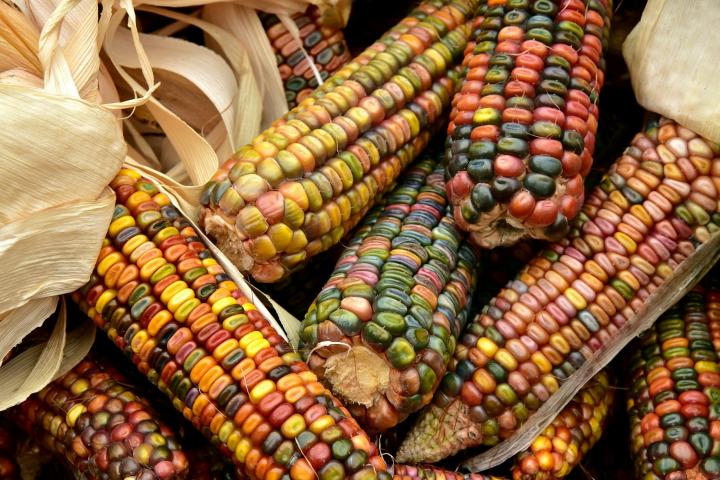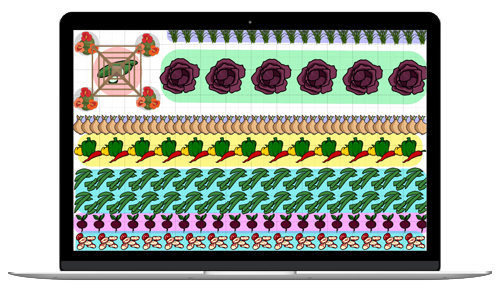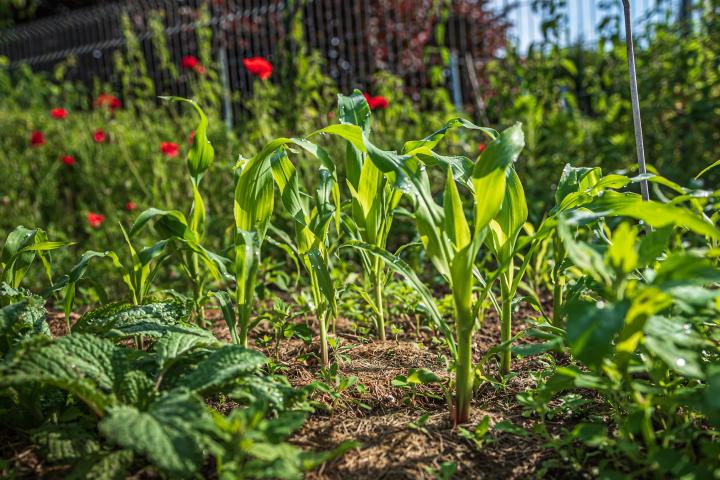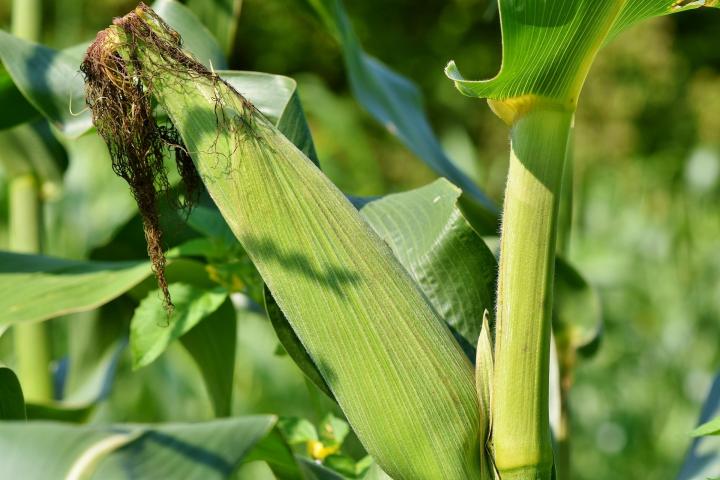
Planting, Growing, and Harvesting Sweet Corn
The Almanac Garden Planner - Use It Free for 7 Days!
Plan your 2025 garden with our award-winning Garden Planner.
Types
Types of Sweet Corn
There are four main types of hybrid sweet corn: sugary (su), sugar-enhanced (se), shrunken (sh, sh2), and synergistic (sy). Each one contains a different level of sucrose, changing the flavor and texture of the corn.The type of corn will be listed right on the seed packet.
It’s important to be aware of which type of corn you’re growing—not only because of the sugar content, but also due to how easily the types can cross-pollinate. If the wrong combination of types cross-pollinates, the ears that are produced may be of subpar quality.
- Sugary (su) sweet corn is the classic sweet corn. Sugary varieties grow vigorously and are stress resistant. The kernels aren’t too sweet and are said to have a “traditional” taste. However, the sugars in sugary sweet corn quickly turn to starch after the ears are picked, so they need to be eaten right after picking. Do not plant near shrunken or synergistic types.
- Sugar-enhanced (se) sweet corn is slightly sweeter than sugary varieties. They keep their sweetness for a longer period of time after harvest (a few days) than sugary varieties. They grow well with few issues. Do not plant near shrunken types.
- Shrunken (sh, sh2) sweet corn—also called “supersweet”—are the sweetest varieties, containing two to three times more sugar than sugary varieties. The sugar in their kernels lasts even longer after harvest (up to a week) than the other types, but kernels tend to be more crunchy and not taste as “corny.” Shrunken types are also more finicky overall. Do not plant them near any other types; hybrid kernels turn out starchy and tough.
- Synergistic (sy) sweet corn combines sugar-enhanced with one of the other two types to create varieties that have the best of both worlds. Synergistic types tend to have very sweet, tender kernels with a good taste and some synergistic varieties can keep up to a week after harvest. Do not plant near sugary or shrunken types.
Recommended varieties include:
- ‘Argent’: sugar-enhanced variety, good taste. White kernels.
- ‘Iochief’: midseason, normal-sugar variety. Yellow kernels.
- ‘Luther Hill’: dwarf, normal-sugar variety. Produces 4- to 6-inch ears on 4- to 5-foot stalks. White kernels. Grow at least nine dwarf plants in a block of three or four rows.
- ‘Silver Queen’: normal-sugar variety. Resistant to some bacterial diseases. White kernels.
- ‘Sweet Sunshine’: supersweet variety. Disease resistant and high yield. Yellow kernels.
Corn can be a feast for the eyes, too! Look for these ornamental varieties:
- ‘Glass Gem’: Sporting multi-colored, semi-transparent kernels, this is a favorite for kids.
- ‘Painted Mountain’: Looking for the classic “maize” colors? This variety has a great diversity of natural tones. Check out our video to learn more about growing and using painted mountain corn.

Cooking Notes
- If too much hot pepper or spice has been added to a soup or stew, adding a can of sweet corn can help.
- Popcorn is also a favorite snack if you have leftover kernels. Learn how to make homemade popcorn here.
ADVERTISEMENT
My corn is about 6ft tall and just starting to develop tassels. This is my first time growing corn, and just realized my stalks don’t have ears, as well as having some yellowing at the base. I looked it up and my best guess is a nutrition deficiency, so I’ve added some nitrogen and more calcium. My question is, at this point if the issue was nutrients, is there enough time for ears to develop before the tassels are no good? Should I wrap the tassels to preserve the male pollen for when there are ears?
If you have tassels, it’s not pollination. And if your corn looks tall and green but lacks ears, it might be overcrowded, and your plantings are too thick. However, the yellowing that you mention, plus the lack of ears, does indeed suggest nitrogen deficiency. It’s hard for us to diagnose from afar, and you should call your local county extension services. In terms of a solution, there are mixed results on late-season nitrogen application for corn. If your corn already had a nice nitrogen application in fall/spring, and it’s the weather called some leaching, it may work. If the corn lacked nitrogen all along, it probably wouldn’t make up the yield. But you might as well try it. Here is a good reference from the Purdue extension.
We are going corn crazy over here. We educate people about the low FODMAP diet, and there is a lot of confusion about what you can and cannot eat. Corn is so versatile, from fresh to all the various dried and ground versions, we absolutely love it. If anyone is suffering with irritable bowel syndrome and/or following the low FODMAP diet, and loves corn, check out our article, Is Corn Low FODMAP?, and let us know if you have any questions! https://www.fodmapeveryday.com/is-cheese-low-fodmap/
I really appreciate this article on corn and have a question. This is our first year having grown popping corn which was going really great till some very adorable squirrels got into it and after trying a bunch of different ways to keeps them out of the corn we finally decided to pull the fully ready ones (not dried) and are hoping it’s possible to dry them inside but is it possible? The rest we left with cages over the ears of corn. Not mad at the squirrels bc it’s just nature but hoping we will still be able to have something to show for it. Thank you in advance
You can keep the squirrels and other critters away by using a spray called bonide. It keeps animals away without harming them or your crops
Dear Ello,
Thank you for your note about your furry wild popcorn-loving neighbors. Yes, if the corn is ripe, you can dry the ears inside. Here is our guide to growing popcorn including advice for harvesting and drying. Good luck and happy popping!
—The Editors
This is my first year growing corn in my backyard garden.
Trying to find out what to do after harvest has been quite difficult/information is unclear.
Do we leave the stalks in the ground for a while after harvest? Remove entirely/to a certain height?
Thanks,
Ontario, Canada 🇨🇦
You will want to remove the stalks soon after harvest. There are a number of pests that will use what remains after harvest as a winter home and by removing the stalks you will greatly reduce their chances of survival. But you have a few options of what to do with your stalks.
You can cut them down and put them in your compost pile. We suggest cutting them up some to increase the rate of decomposition. You will then want to till the stalk nubs back into the soil. You can also till all of it into the soil. There are a lot of great nutrients that remain in corn stalks and it will provide good organic matter for next year’s plantings once it breaks down.
And if you want to think ahead, cut some of the stalks and dry them upside down and they will make for great decor when fall rolls around!
Could you please post how you boil corn and how you barbeque it. How long should you boil it for or leave it on the barbeque. Thank you
Hi, Louise. When you boil corn on the cob, allow the water to come to a full boil and then add in the ears of corn. Cook it for 5 minutes. When it comes to cooking corn on the cob on the grill there are several methods. Try this: peel the corn and remove the silk. Pull the husks back up and then soak the ears in salted water for about 10 minutes. Remove and make sure to shake off any excess water. Place the ears on the grill, close the lid, and turn every 6 minutes. Your corn should be ready after 20 minutes.












